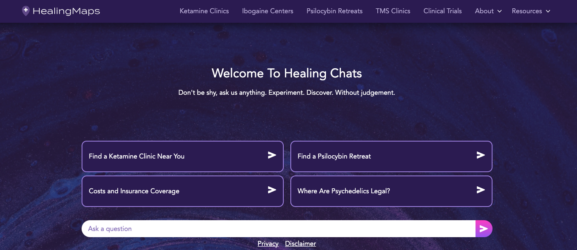Tens of Thousands of Trained Psychedelic Practitioners Needed, Experts Say
Turn on CNN, and you’ll see trauma unfolding in front of you.
For some of the worst mental health conditions, such as PTSD, new medicines are coming. MDMA-assisted therapy is likely to be legal in a year or two, as a treatment for post-traumatic stress disorder. Notably: you won’t be able to just take a pill on your own or at a rave. You’ll have to dose with someone at your side.
One problem: there aren’t nearly enough people trained in the art of sitting. We’re talking therapists, doctors, psychiatrists, nurses, guides, hand-holders, healers.
Tens of thousands more people will need training in psychedelic-assisted therapy over the next decade or so if the new legal system is going to work well.
“One key challenge for us is going to be properly training therapists,” Rick Doblin, the head of the Multidisciplinary Association of Psychedelic Studies, which is taking MDMA-assisted therapy through the FDA process, said on a recent episode of the Psychedelics Today podcast. “Our treatment is the human relationship, the therapy, and then the psychedelic makes the therapy more effective.”
According to a study done on the Premise, Promise, and Challenges of MDMA assisted therapy for PTSD published earlier this year, “training of therapists … is possibly one of the biggest challenges ahead and most likely the main limiting factor for wide-spread availability of this novel treatment in the near future.”
RELATED: Here’s How Clinics are Getting Ready for MDMA and Psilocybin

How Many Practitioners Do We Need?
No one knows with certainty.
According to a study done on the Economics of Psychedelic-Assisted Therapies published in 2022, “a modeling effort by the Boston Consulting Group estimated that 22,000-40,000 MDMA certified practitioners would be needed to treat 400,000 PTSD patients by 2031. Considering psychedelic medicine more broadly, this implies that treating one million patients per year by 2031 would require 55,000-100,000 newly-trained therapists in 10 years, approximately 10-17 percent of the US mental health workforce.”
There are tricky nuances to work out as well. For example, the study also found that “75 percent of therapists reported they would be unlikely to provide psychedelic therapy if it meant a reduction in income.” Psychedelic sessions are long, and therapists might not be able to charge their usual rate for every hour they’re working.
RELATED: 9 Easy Ways to Stimulate Your Vagus Nerve
Two Sitters, Not Just One, Likely Needed in Each Session
One hurdle that makes access to psychedelic therapy more difficult as well is the fact that treatment will require two people trained in MDMA-assisted therapy.
The training required to administer MDMA-assisted therapy is highly specialized, and only available through a limited number of training programs at the moment. With notable exceptions (such as the training program offered by Numinus), most programs require a mental healthcare license for admittance.
(If you are interested in learning more about “How to Become a Certified Psychedelic Therapist”, and the many nuances, check out a recent piece I wrote on the topic here).
It is also still a mystery what other requirements the FDA will create to be legally able to administer MDMA. It’s not clear whether both people in the room during an MDMA-assisted therapy session will need licenses in mental health. It’s possible the second person can be someone with a different background.
There are also legitimate concerns about what a psychedelic therapy session will cost a patient, and whether their insurance will cover it in part or in full.
RELATED: Solving the Insurance Puzzle: How to Get Your Ketamine Therapy Covered
Shortcomings of Current Treatments
The current treatments for PTSD leave much to be desired. These include Cognitive Behavioral Therapies, EMDR, and prescription drugs like antidepressants.
While these treatments can be effective for some people some of the time, the sad truth is that they are simply not effective enough for most people. Especially for the unlucky patients who find themselves fighting the notorious “treatment-resistant” PTSD.
There is also the fact that SSRIs and benzodiazepines were mostly created for depression and anxiety, respectively. Depression and anxiety are symptoms of PTSD, but they do not lie at the heart of the issue.
With people holding their collective breath, MAPS PBC (Public Benefit Corporation) just published the results of a successful confirmatory phase 3 trial of MDMA-assisted therapy. The study “met primary and secondary endpoints confirming the first phase 3 study findings.”
With the completion of all phases of the FDA approval process, there is not much standing in the way of federal MDMA legalization as a therapeutic medicine. MAPS expects to file the new drug application for MDMA with the U.S. Food and Drug Administration before the end of the year.
Millions of Sufferers Seek New Treatments
Although modern society provides us with more comfort and safety than our ancestors ever could have imagined, it also comes at a cost: increased stress, mental illness, and scarcity.
Over 50 million Americans experienced a mental illness in 2019. Worse yet, one third of all adults with a mental illness reported they were not able to receive the treatment they needed.
PTSD alone cost the United States 232.2 billion dollars in 2018, and 3.5 percent of Americans suffer from PTSD every year.
These frightening figures are also why psychedelic medicine provides much needed hope for so many who are suffering.
We got the chance to chat with Payton Nyquvest, founder at Numinus, about his thoughts on the historic news.
“This moment represents a significant milestone not just for the healthcare and psychedelic industries, but also for humanity as a whole,” says Payton. “Millions of people living with PTSD are hoping to access MDMA-assisted therapy as a safe, effective healing modality. These positive Phase 3 results represent a genuine and promising leap toward formally acknowledging this treatment and providing universal access.”
Payton also gives credit to MAPS for their relentless pursuit of MDMA-assisted therapy legalization.
“It goes without saying that the industry tips its hat to Rick Doblin and the entire MAPS team. They have been tirelessly advocating for the mental health industry through their work over the past 38 years, guiding us on this crucial journey. The Numinus team is proud to be a longstanding ally and partner of MAPS and will continue supporting the organization’s efforts and advocacy with our extensive resources in the US and Canada.”
Effective medicines and therapies are needed now more than ever, many experts believe.
GET CERTIFIED: Psychedelic-Assisted Therapy Certifications and Training
What Happens if There Aren’t Enough Practitioners?
The economic and mental health benefits of MDMA-assisted therapy are obvious. The need for more effective mental health treatments is dire. The demand for psychedelic therapy will be high. That much is clear. The prospect of legal psychedelic-assisted therapy without enough trained practitioners is a bit grim.
Long Wait Times
Psychedelic therapy with limited supply could create massive wait times to schedule an appointment. With a limited number of trained therapists, patients may have to wait weeks or months for a psychedelic session. Many of these patients are experiencing extreme symptoms, and waiting months for an appointment is not feasible, or kind.
High Expenses
With supply low and high demand, psychedelic therapy will cost a significant amount of money. Starting out, MDMA-assisted therapy may cost “anywhere from $10,000 to 15,000.” Health Insurance may choose to forgo coverage. That’s despite MDMA-assisted therapy being likely to generate net savings to health payers by reducing overall health care costs”, according to a study.
Increasing the supply of psychedelic therapists will help reduce costs.
Big Future for MAPS
Doblin, the head of MAPS, sees a big future: “With thousands and thousands of psychedelic clinics with therapists cross-trained in ketamine, MDMA, psilocybin, and 5-MeO-DMT, there will be a different kind of education seeping into the culture.” Doblin and others need therapists to carry out the dream of providing access to psychedelic medicine-assisted therapy to patients from every background. What the therapists need are financial incentives high enough to entice mental healthcare professionals to invest in psychedelic training. It’s a balancing act, one many hope the profession can get right.



